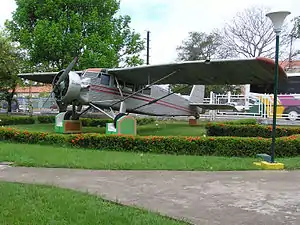| Flamingo | |
|---|---|
 | |
| G-2-W Flamingo El Rio Caroní, on display at Ciudad Bolívar airport, in Venezuela | |
| Role | Passenger monoplane |
| National origin | United States of America |
| Manufacturer | Metal Aircraft Corporation |
| Designer | Ralph R. Graichen |
| First flight | 8 April 1928 |
| Status | Retired |
| Number built | 21 |
The Metal Aircraft Flamingo was a monoplane produced in Cincinnati, Ohio by the Metal Aircraft Corporation in the 1930s.[1]
Design and development
The Metal Aircraft Corporation purchased the design from the Halpin Development Co. and unveiled it at the 1929 National Air Races with Elinor Smith.[2][3] Following an accident at Bowman Field in May 1928, the prototype Flamingo was redesigned with a different nose, windscreen, and tail.[4] The interior was insulated with Balsam-Wool Blanket.[5]
Operational history
The Flamingo was first flown from Lunken Airport on 8 April 1928 by Thomas E. Halpin.[6] At one point, the aircraft carried an African-American porter in a red suit named Benny Smith.[7] Following a teaser, marketing for the new airplane began in March 1929 and dealers were being solicited by the following month.[8][9][10]
One G-2-W, named El Rio Caroní, is best remembered for its role in the discovery of Angel Falls by Jimmy Angel in 1935. Although well known to the local indigenous population, the falls had been glimpsed only by European explorers until Jimmy Angel crash-landed while attempting to land above the falls on Auyán-tepui during gold exploration.
The Metal Aircraft Corporation Flamingo that crashed above the falls was recovered by helicopter in the 1960s by the Venezuelan government and is on display at the entrance of the Ciudad Bolívar airport, in Venezuela. A replica was put in its place for visitors of the crash site.[11]
Other operators included the Mason & Dixon airline.[2] Another operator of the aircraft was United States Airways which flew a route from Denver to Kansas City in the early 1930s. Stops were made Goodland, Salina, and Topeka, Kansas.[12]
Variants

- Halpin Flamingo
- six-passenger 410hp P&W[13]
- G-1
- five-passenger 450hp P&W
- G-2
- six-passenger
- G-2-H
- six-passenger 525hp P&W

Operators
| External image | |
|---|---|
Accidents and incidents
- On 26 May 1928, a Flamingo nosed over on landing at Bowman Field in Louisville, Kentucky, injuring the pilot, mechanic, and a passenger.[20]
- On 8 November 1930, a G-2 operated by the Embry-Riddle Company made an emergency landing near Indianapolis following an in-flight fire.[21]
Specifications (Flamingo G-2-W)
Data from Skyways, Air and Space[11]
General characteristics
- Capacity: eight
- Length: 32 ft 6 in (9.91 m)
- Height: 9 ft 6 in (2.90 m)
- Empty weight: 2,960 lb (1,343 kg)
- Gross weight: 5,600 lb (2,540 kg)
- Powerplant: 1 × Pratt & Whitney R-1340 Wasp 9-cyl. air-cooled radial piston engine, 410 hp (310 kW)
Performance
- Maximum speed: 117 kn (135 mph, 217 km/h)
- Cruise speed: 100 kn (115 mph, 185 km/h)
- Range: 870 nmi (1,000 mi, 1,600 km)
- Rate of climb: 800 ft/min (4.1 m/s)
References
- 1 2 "Halpin Flamingo". Cincinnati Aviation Heritage Society & Museum. Archived from the original on 15 March 2016. Retrieved 4 July 2021.
- 1 2 McClure, Rusty; Stern, David; Banks, Michael A. (9 November 2006). Crosley: Two Brothers and a Business Empire that Transformed the Nation. Clerisy Press. ISBN 978-1578602919.
- ↑ Grey, C.G., ed. (1928). Jane's all the World's Aircraft 1928. London: Sampson Low, Marston & company, ltd.
- ↑ Gampfer, Scott (29 May 2018). "The Flamingo Takes Flight: Cincinnati's First All-Metal Airplane, Pt. 2". Cincinnati Museum Center. Retrieved 28 August 2018.
- ↑ "[Advertisement]". Aero Digest. Vol. 15, no. 4. Aeronautical Digest Publishing Corporation. October 1929. p. 263. Retrieved 4 July 2021.
- ↑ "First Flight of Home Ship Success". Cincinnati Enquirer. 9 April 1928. p. 10. Retrieved 22 December 2020.
- ↑ "PersonAIRLities". Aero Digest. June 1928. p. 954. Retrieved 24 May 2021.
- ↑ "March 1". Aero Digest. Vol. 14, no. 2. Aeronautical Digest Publishing Corporation. February 1929. p. 16. Retrieved 4 July 2021.
- ↑ "All Metal Flamingo for Greater Operating Profit". Aero Digest. Vol. 14, no. 3. Aeronautical Digest Publishing Corporation. March 1929. p. 16. Retrieved 4 July 2021.
- ↑ "Aircraft Dealerships". Aero Digest. Vol. 14, no. 4. Aeronautical Digest Publishing Corporation. April 1929. p. 13. Retrieved 4 July 2021.
- 1 2 Skyways. July 1999.
{{cite journal}}: Missing or empty|title=(help) - 1 2 United States Airways, 20 February 1933, retrieved 24 May 2021
- ↑ "The Halpin "Flamingo"". Aero Digest. Vol. XII, no. 5. Aeronautical Digest Publishing Corporation. May 1928. pp. 800, 802. Retrieved 28 August 2018.
- ↑ "The Flamingo G-2-W". Aero Digest. Aeronautical Digest Publishing Corporation. March 1929. pp. 94, 96. Retrieved 28 August 2018.
- ↑ "Milk Pickets Balked by Airplanes". Aero Digest. February 1934. p. 56. Retrieved 24 May 2021.
- ↑ "Sky Trail to Be Opened from Gateway City with Planes' Pioneer Flight South Today". Cincinnati Enquirer. 1 May 1931. p. 15. Retrieved 4 July 2021.
- ↑ "Gilmore Farmer Flys New Fort Dodge Plane". Humboldt Independent. 5 January 1932. p. 1. Retrieved 4 July 2021.
- ↑ "Efficiency Rating". Aero Digest. August 1929. p. 125. Retrieved 24 May 2021.
- ↑ "Aviation Lanes". Cincinnati Enquirer. 4 November 1934. p. 2. Retrieved 4 July 2021.
- ↑ "3 Injured Here in Plane Crash". Courier-Journal. 27 May 1928. p. 1. Retrieved 25 May 2021.
- ↑ Goutierez, Russell (3 July 2019). "Charred Seats and Cow Pies: The Day a Flamingo Ran With the Bulls". World Airline Historical Society. Retrieved 24 May 2021.